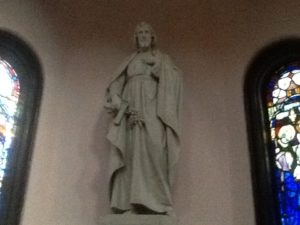
Eleanor Roere was born in Turin on the first day of October in the year 1638, the day on which our worthy Mother de Chantal and her virtuous daughters arrived in this city to establish a Monastery. Does it not seem that the Institute of the Visitation came to receive this dear child from the maternal womb, to tear her from the world and its seductions and to make her a bride of Jesus Christ, a propagator of our Congregation, who was it to help so powerfully to establish in the cities of Rome and Naples?
Her mother brought her to the Visitation Monastery School in Turin.Her first teacher, the very honored Mother Marie-Françoise de Corbeau, cultivated her excellent dispositions.
A grace imprinted in Eleanor’s soul an ardent devotion to the adorable Eucharist. She honored Mary with a special prayer, especially her very pure and immaculate Conception. She confidently invoked her holy Guardian Angel and called him unceasingly to her help, as well as the glorious Saint Joseph, whom she called the Father of her soul.
Around the age of thirteen, M. le Comte de Roëre withdrew her from the convent and took her to one of his estates, in the company of a young cousin, a young lady of rare beauty. The lords of the court and of the province soon came in crowds; every day there were new entertainments, fun parties, games, trips, balls and great companies. Eleanor insensibly took a liking to it; his mood grew happier and more playful. She felt flattered by the many researches of which she was the object; several months passed in these vanities, but finally the celestial husband made him hear in the depths of his heart the complaints of his divine jealousy; she could not resist it, asked for her return to the Monastery, and showed so much joy on returning to the house of the Lord that everyone believed that she was accomplishing this heroic act without difficulty.
She deserved to take the holy habit at the end of two months. The ceremony took place on the day of Sainte-Thérèse with extraordinary magnificence, in the presence of Madame Royale Christine of France, His Royal Highness Charles-Emmanuel, the princesses and the illustrious family of the Counts of Roëre.She continued her novitiate by walking in the paths of justice and speaking so little that her companions said: “We see her doing more than saying,” and, when we are preparing for some act of mortification, she already has it ” executed.he ceremony of the profession of our dear Sister was done with the same solemnity as her dress and in the presence of the same assembly.
Sæur Cécile-Marguerite was then appointed to the various offices of the house: sacristin, treasurer, mistress of boarders; everywhere she gave proofs of her capacity and of the strength of her mind. She knew how to satisfy everyone without neglecting anything of her duties towards God or of the observance of his Rule. In addition, the Superiors employed her early as secretary, and found in her a help always ready to relieve them.
She lived by faith, like the righteous, having few sensible consolations; God all love, and alone worthy of all the love of his creature, such was the principal occupation of her mind and of his heart. Not only did this true Religious observe poverty rigorously by depriving herself of any superfluity, but she never availed herself of the continual gifts that her father gave her. They were no sooner in the Monastery than she left them indifferently for the use of all the Sisters.
It was on August 21 of the year 1668 that our Sister Cécile-Marguerite and her virtuous companions left the Monastery of Turin. The details of the trip, their visit to Notre-Dame de Lorette, the audience that His Holiness Clement IX deigned to grant them, the various events which made the foundation of Vétralle fail and gave rise to that of Rome,
She was keen that the Visitation Monastery of Rome should be established in exact observance. Her tender devotion to the Blessed Virgin, to Saint Joseph and to our holy Founders was most remarkable; she had oratories erected in their honor and took pleasure in decorating them with her own hands. Animated by zeal to make our glorious Father known and loved, she always mixed in her familiar conversations some of the maxims of this Blessed One. Thanks to her prayers and supplications, the feast of this holy Patriarch was placed among the double feasts for the whole Church, and when she learned that the Holy See had approved her request, she returned them to God.
Eventually the foundation of our Monastery of Naples was made, for which she had worked for nearly fifteen years.
The last three days of her life were embellished by the sweet consolations of the divine Bridegroom. It was united to Him and full of the desire to possess Him that she returned her holy soul to God. She remained so beautiful after her death that one would not have judged that she had ceased to live.